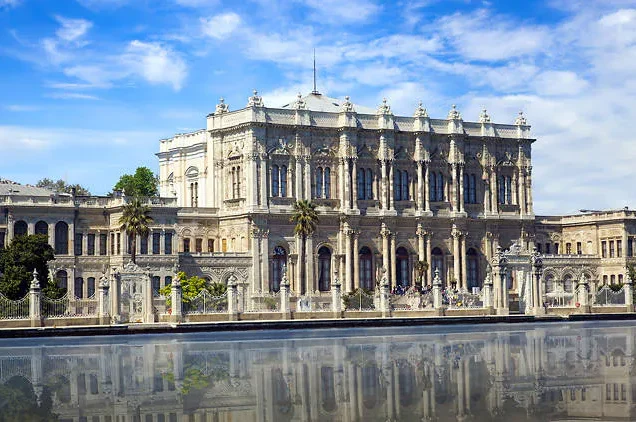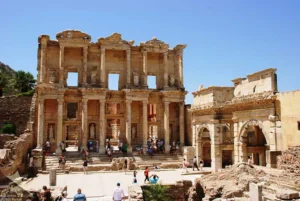Istanbul Full Day Cıty Tour 4
Duration
9 Hours
Max People
?
Min Age
2
Pickup
Taxi
Tour Programme
Topkapı Palace,Hagia Irene Church,Blue Mosque,Hagia Sophia,Hipodrome,Ibrahim Pasha Palace(From Outside),Haseki Hurrem Sultan Hamam(From Outside)-Lunch,Boat trip on the Golden Horn and Bosphyorus – Bosphorus Bridge,Maiden tower (from the sea)Transport and Guide Everyday(Except Tuesday) This program is only in Russian language.
Topkapı Palace
Topkapi Palace was built in 1478 and has been the center of the Ottoman Empire for 380 years. The palace, whose current area is 80 acres, was 8-9 times larger in its first years.The name "Topkapi" was given to the palace because one of the gates of the Istanbul castle in Sarayburnu during the Byzantine period was named Topkapi.
The palace had seven great gates, four facing the land and three facing the sea. The palace was mostly entered through the door called "Bab-ı Hümayun" in front of Hagia Sophia. There is the Middle Gate 300 meters inside from this gate. Grand Viziers had to dismount at the Middle Gate and enter on foot. There is a promenade called the "First Place". In the Palace Kitchen on the right, enough food was cooked for 15,000 or even 20,000 people. At the end of the promenade, there is the harem gate and the Kubbealtı where the viziers gather. After the Middle Gate, the Akağalar Gate, also called "Bab-us Seade", comes. In this part, Baghdad Mansion, Kara Mustafa Pasha Mansion,Mecidiye Mansion, Revan Room, Cardigan Room, Circumcision Room, Tulip Garden are located. All these constituted the "Selamlik" part of the Palace. The "Harem Department" was one of the most interesting corners of the Palace. The mothers, wives concubines and journeymen of the sultans lived here. In addition, the residence of the sultan was also located here. III. Murat's bedroom was the most magnificent place in the entire Topkapi Palace, not in the Harem.
Hagia Sophia
The construction of Hagia Sophia began on 2 December 532 and was completed on 27 December 537. Hagia Sophia is of great importance for its own period and for the following periods. HagiaSophia, which is shown among the 8 wonders of the world, was used as a church for 916 years and as a mosque for 481 years. Hagia Sophia was built by combining the traditional basilical plan and the central domed plan. The building has three naves, an apse, and two narthexes, inner and outer. The length from the apse to the outer narthex is 100 m. width is 69.50 m. The height of the dome from the ground is 55.60 m, its diameter is 31.87 m in the north-south direction and 30.86 m in the east-west direction.
There are 104 columns in the building, 40 of which are in the lower gallery and 64 are in the upper gallery. Except for the marble-covered walls of Hagia Sophia, all surfaces are decorated with beautiful mosaics. Materials consisting of gold silver, glass, terracotta and colored stones were used in the making of the mosaics. The vegetal and geometric mosaics in the building are dated to the 6th century, and the depicted mosaics are dated after the iconoclasm (Depiction Breaker Period 730-842). Hagia Sophia was converted into a mosque after Fatih Sultan Mehmed (1451-1481) conquered Istanbul in 1453. Right after the conquest, the building was strengthened and preserved in the best way and continued its existence as a mosque with the additions of the Ottoman Period. Buttresses were built to support the structure, which was damaged by various earthquakes since the date it wasbuilt, both in the Eastern Roman and Ottoman periods. The minarets built by Mimar Sinan also serve as supporting buttresses in the building.
During the Ottoman period, in the 16th and 17th centuries, altars, pulpit, muezzin mahfils, sermon pulpit and maksures were added to Hagia Sophia.
Written by Calligrapher Kadıasker Mustafa İzzet Efendi during the reign of Sultan Abdulmecid, 7.5 m. 8 line boards in diameter were placed on the walls of the main space. “God, St. Mohammed, Mr. Abu Bakr, Mr. Omar, Mr. Osman, Mr. Ali, Hz. Hasan and Hz. These plates with the inscription "Hussein" are known as the largest calligraphy plates in the Islamic world. The same calligrapher wrote the 35th verse of Surah Nur in the middle of the dome.
The Blue Mosque
The Blue Mosque was built by Ahmet I, between 1609 and 1617, by Sedefkar Mehmet Ağa, one of the most important architects after Sinan.
Sultanahmet, which was subjected to many criticisms after its construction was completed, is the first and only mosque with 6 minarets within the borders of the Ottoman Empire. The reason why it was exposed to criticism is that it has the same number of minarets as the Mecca Mosque. Another reason for criticism was the high amount of money spent on this mosque, despite the decrease in Ottoman income at that time. Sultan Ahmet I put an end to some of these criticisms by having the 7th minaret built on the Mecca Mosque.
There are 16 balconies in the Blue Mosque, and these balconies were thought this way because Ahmet I was the 16th Sultan to the throne. The Blue Mosque had a very large area when it was first built, but a large part of the complex, which consists of structures such as a madrasa, sultan palace, almshouse, arasta, and hammam, has not survived until today. The single-domed tomb of Ahmet I, who died at the age of 28, is located in the garden of the Sundial Mosque. There is a cordon made of iron at the main gate of the Blue Mosque, whose courtyard can be entered through 3 gates. By placing this cord at the entrance, it was intended to give the message "Even the sultan who comes to the house of Allah has to bow when entering".
The interior of the Blue Mosque is seated on 4 pillars and is covered with a magnificent 43-meter-high dome. The diameter of the dome is 23.5 meters. Blue, which is the dominant color in the patterns in this part of the mosque, was used during repairs in different periods.
Approximately 22000 tiles from Iznik and Kütahya decorate the walls of the mosque. The motifs of different flower types are embroidered on the tiles, which have a great role in attracting the attention of the mosque. Thanks to the 260 windows that illuminate the building, the tiles display a very beautiful appearance, especially on days when the weather is clear. After Hagia Sophia became a museum in 1924, it became the main mosque of Istanbul.
Tour Map
| Min - Max (Persons) | Adult Price | Children Price | Baby Price |
|---|---|---|---|
| - - - | €120.00 | €120.00 | €0.00 |























Valoraciones
No hay valoraciones aún.